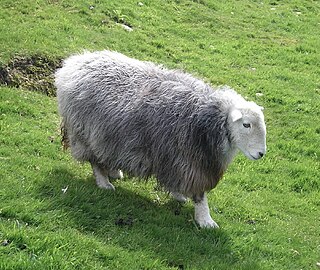
The Herdwick is a breed of domestic sheep native to the Lake District in North West England. The name "Herdwick" is derived from the Old Norse herdvyck, meaning sheep pasture. Though low in lambing capacity and perceived wool quality when compared to more common commercial breeds, Herdwicks are prized for their robust health, their ability to live solely on forage, and their tendency to be territorial and not to stray over the difficult upland terrain of the Lake District. It is considered that up to 99% of all Herdwick sheep are commercially farmed in the central and western Lake District.

The Hampshire Down or Hampshire is a British breed of sheep. It originated in about 1829 from cross-breeding of Southdowns with the Old Hampshire breed, the Wiltshire Horn and the Berkshire Nott, all horned, white-faced sheep — these were native to the open, untilled, hilly stretch of land known as the Hampshire Downs. It is much used as a terminal sire.
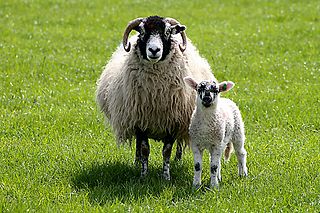
Swaledale is a breed of domestic sheep named after the Yorkshire valley of Swaledale in England. They are found throughout the more mountainous areas of Great Britain, but particularly in the Yorkshire Dales, County Durham, and around the pennine fells of Cumbria.

The Lonk is a British breed of domestic sheep. It belongs to the group of black-faced hill breeds of northern England, and is found in the hills of the central and southern Pennines of Lancashire and Yorkshire. It is documented from the mid-eighteenth century; a flock book was started in 1905.

The Romney, formerly called the Romney Marsh sheep but generally referred to by the local farmers as the Kent, is a breed of sheep originating in England. The Romney is a "long-wool" breed recognized in England by 1800. Exported to other continents, the Romney is an economically important sheep breed, especially to the sheep-meat and wool export trades of New Zealand.
The Whiteface Dartmoor is a breed of domestic sheep originating in the Dartmoor region of south west England. The Rare Breeds Survival Trust has designated this breed as "at risk".

The Shetland is a small, wool-producing breed of sheep originating in the Shetland Isles, Scotland, but is now also kept in many other parts of the world. It is part of the Northern European short-tailed sheep group, and it is closely related to the extinct Scottish Dunface. Shetlands are classified as a landrace or "unimproved" breed. This breed is kept for its very fine wool, for meat, and for conservation grazing.

The Norfolk Horn is one of the British black-faced sheep breeds. It differs from other black-faced breeds, which are mainly found in high-rainfall, upland areas, and from most other modern, lowland British sheep breeds in being lightly built and very hardy. This breed is raised primarily for meat.

Welsh Mountain sheep are small, hardy sheep from the higher parts of the Welsh mountains. The males have horns, and the females are polled (hornless); they have no wool on the face or legs, and they have long tails. There are a number of varieties, bred for sheep farming in Wales. These are mainly colour variations, but some are being developed as separate breeds.

The raising of domestic sheep has occurred in nearly every inhabited part of the globe, and the variations in cultures and languages which have kept sheep has produced a vast lexicon of unique terminology used to describe sheep husbandry.

The Clun Forest is a breed of domestic sheep originating from the area surrounding the Clun Forest in Shropshire, England. Similar to many of the British breeds of upland sheep, Clun Forest are hardy, adaptable, good foragers, and are long–lived. With sleek heads and wide pelvic structures, Clun Forest ewes lamb easily. The breed has a short to medium–length wool and dark brown faces. They are a multi–purpose animal, kept for meat, wool, and milk. Like other dark faced sheep, Clun produce quality lamb and mutton. However, in contrast to more common meat breeds such as Suffolks, their wool is free of undesirable black fibres and kemp, and is suitable for handspinning. The breed's alert and stylish appearance, together with its reputation for hardiness and fecundity have made it popular with hobby farmers and large commercial flock owners alike. The Official Clun Sheep Breeders Society Show & Sale for males and females is held annually in early September at Ludlow livestock market by McCartneys.
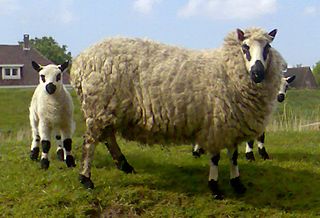
The Kerry Hill is a breed of domestic sheep originating in the county of Powys in Wales. It derives its name from the village of Kerry (Ceri), near Newtown. Kerry Hill sheep have a distinctive and unique coloration, with a white face bearing black markings around the mouth, ears, and eyes. Both rams and ewes are polled. Their wool is white, and their legs are white with black markings. First mentions of the breed date back to the early 19th century, and today it is distributed throughout the United Kingdom, Ireland, the Netherlands, Germany and Denmark. Though still not very numerous, the breed was removed from the records of the Rare Breeds Survival Trust watchlist in 2006. This breed is primarily raised for meat.
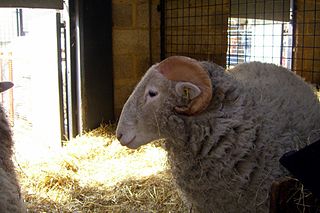
The Whitefaced Woodland is a sheep breed from the Woodlands of Hope an area in the South Pennines in England. It is a combination of two breeds, the Woodland and the Penistone sheep after the Yorkshire town where sheep sales have been held since 1699. It is thought to be closely related to the Swaledale and the Lonk. Substantial commercial flocks of the Whitefaced Woodland are kept in its region of origin, but it is listed as a vulnerable breed by the Rare Breeds Survival Trust, since there are fewer than 900 registered breeding females in Great Britain.

The Racka or Hortobágy Racka Sheep is a breed of sheep known for its unusual spiral-shaped horns. These unique appendages are unlike any other domestic sheep horns, and may grow up to 2.0 ft (0.61 m) long. The smallest standard length is 20 in (51 cm) for rams and 12–15 in (30–38 cm) for ewes.
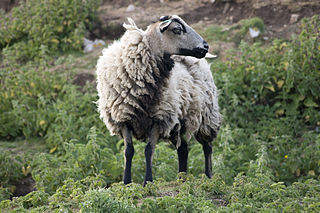
The Badger Face Welsh Mountain is a distinct variety of the Welsh Mountain breed of domestic sheep bred for sheep farming in Wales. It is a hardy upland breed known for producing a high percentage of twins and triplets under good conditions. It appears in two sub-varieties of its own: the Torddu, which has a white fleece with dark face and belly, and the Torwen, which has a black body with a white belly and white stripes over the eyes. The Torddu is the more common of the two types. In both types, ewes are polled and rams are horned. Although this breed grows wool, it is primarily raised for meat.

The Dalesbred is a breed of domestic sheep originating in England. Derived from the Swaledale and Scottish Blackface breeds, the Dalesbred is a northern hill breed distributed in the Yorkshire Dales and into Lancashire. The Dalesbred is genetically distinct from the other northern hill breeds, the Herdwick and Rough Fell.
The Devon Closewool is a British breed of domestic sheep. It is distributed almost exclusively on Exmoor in North Devon, in south-west England. It is raised primarily for meat.

The Beulah Speckled Face is a breed of domestic sheep originating in the United Kingdom. Having been bred in the uplands of Wales for more than a hundred years, a breed society was officially formed in 1958. This breed is most common in Eppynt, Llanafan Fawr, Abergwesyn, and Llanwrtyd Wells, and it is little known outside Wales. The origins of the breed are unclear; it may be a truly native breed that has been selected to suit the local environment for centuries. The breed is named for its distinctly patterned black and white face, which is free from wool. The ewes, which are naturally polled, are often crossed with lowland rams such as the Suffolk, Texel or Bluefaced Leicester to breed mules, and to produce market lambs for meat. When bred pure, the lambs do not meet today's export demand for lean, fast-growing sheep. However, the ewes make good mothers and produce plenty of milk.

North Country Cheviot is a common breed of sheep raised mainly for meat production. Originated from Scotland.
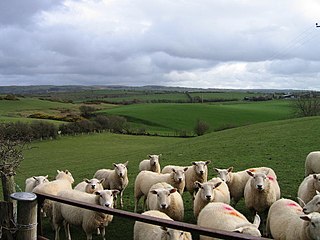
Sheep farming has been important to the economy of Wales. Much of Wales is rural countryside and sheep are seen throughout the country. The woollen industry in Wales was a major contributor to the national economy, accounting for two-thirds of the nation's exports in 1660. Sheep farms are most often situated in the country's mountains and moorlands, where sheepdogs are employed to round up flocks. Sheep are also reared, however, along the south and west coasts of Wales. In 2017 there were more than 10 million sheep in Wales and the total flock made up nearly 33% of the British total. In 2011 sheep farming accounted for 20% of agriculture in Wales.


















